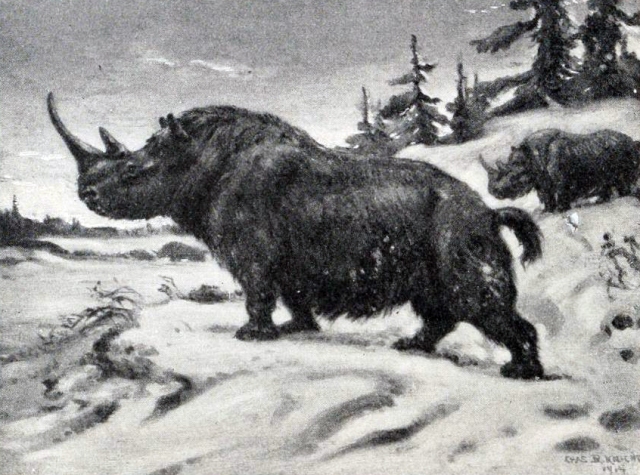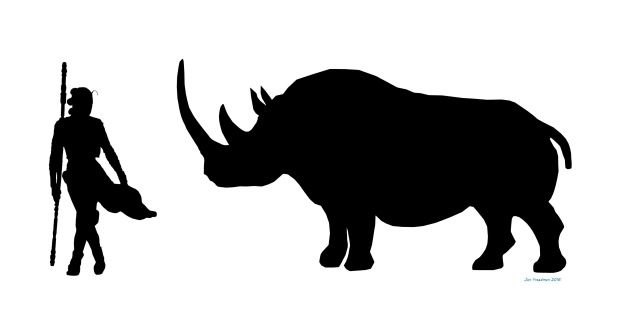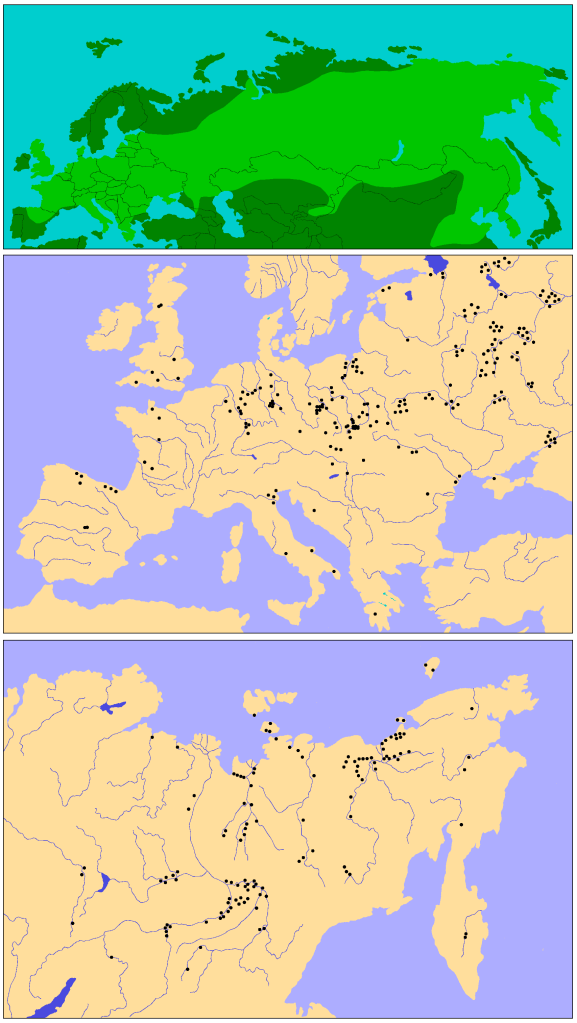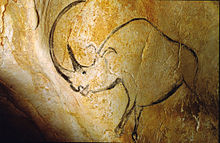Rhinoceros are magnificent beasts. Their muscular and armored bodies sit on top of thick, stocky, legs giving these animals a literally awesome sense of power. Their massive heads, topped with it’s unique horn creates an ancient, almost mythical, persona to this beast. These Titans are often seen with one or a few others; rarely do they move in a big group (also know as a crash). Today there are five species of rhinos; the White Rhinoceros (Ceratotherium simum) (this is actually split into two sub species; the southern white rhinoceros, and the northern white rhinoceros); the Black Rhinoceros (Diceros bicornis) (split into four sub species); the Indian Rhinoceros (Rhinoceros unicornis); the Javan Rhinoceros (Rhinoceros sondaicus); the Sumatran Rhinoceros (Dicerorhinus sumatrensis).
All species of rhinoceros are under threat of extinction today not by changing climate or by increased competition, but by another mammal, the ironically named ‘wise man’, a.k.a Homo sapiens. Hunted for just their horns more and more rhinos are sadly being killed each year. The most threatened and on the verge of extinction, the Sumatran rhinoceros, is the last link to one of the most wonderfully adapted Twilight Beasts the Pleistocene saw.
During the last 2.6 million years there were several different species of rhinoceros adapted for different environments, including the gracile ‘little’ Christol’s rhinoceros (Dicerorhinus megarhinus), the lonely Etruscan rhinoceros (Dicerorhinus etruscus), the warm loving Merck’s rhinoceros (Dicerorhinus kirchbergensis), the colder loving Steppe rhinoceros (Dicerorhinus hemitoechus) and the more familiar Woolly Rhinoceros (Coelodonta antiquitatis).

A strong, proud woolly rhinoceros (Coelodonta antiquitatis) painted by Charles Knight. (Image from here)
Stocky, hairy, and powerful, the woolly rhino was a rhinoceros that could happily live in the blistering cold glacial periods. Incredibly preserved frozen carcasses from Siberia have provided a lot of information about the appearance of these extinct beasts. Their thick skin, with the addition of short fur kept their large bodies warm. Short ears and a short tail also kept out the cold. Frozen carcasses show the feet lacked the splayed padding that was suited for living in deep snowy environments; so instead of spreading the weight over the snow, these rhinos would have sunk into the snow making it very tricky to walk. Cold glacial times were often times of bitter coldness, and also times when the landscapes were dry deserts where very little rain, and snow, fell; perfect conditions for this hairy rhinoceros.
Due to their larger size, bones and teeth of woolly rhinos are more likely to be preserved than smaller mammals, so they are commonly found at Pleistocene sites. These fossils give us a glimpse into their ancient distribution, but also provide more; they can tell us what they ate. It’s massive head was positioned close to the ground, along with thick lips and thick enameled teeth, show that this was a grazing animal. Pollen analysis found in teeth and in frozen specimens show they were mainly eating grasses, mosses and low lying herbaceous plants.

Just Rey alongside a Woolly Rhinoceros to get a sense of the scale of this magnificent creature. (Image by Jan Freedman)
Evolving around 3.6 million years ago in the Tibetan region, the Coelodonta antiquitatis spread westward across Siberia and Europe. However, this big hairy animal was not just restricted to the cold tundra. Fossil finds have shown their distribution to have spread to environments where it was not always cold. Fossils in Spain have been associated with warmer environment where grasses covered the land; not a cold steppe, but a luscious temperate meadow.

The distribution of the Woolly Rhinoceros (Coelodonta antiquitatis). In the top image, the light green band illustrates the distribution across the Eurasian continent. The two images below show where Woolly Rhino specimens have been found, represented by the black dots. (Image from here)
The front horn of the woolly rhinoceros is perhaps one of the most fascinating features of this amazing animal. It was big, perhaps as long as my arm (they could be around 60cm long). A clear use for such a formidable horn was defense against potential predators. Obviously the sizes and shapes varied from individual to individual, but many showed wear or flattening. Some have suggested that this oversized horn was used to clear snow to find the food beneath. However, we have already seen that Woolly Rhinos were not at home in the snow, so this is perhaps an unlikely scenario. It is more likely that the horns were actually used for fighting other males during the rutting season. (To see these magnificent Titans fighting, crashing into each other and grappling with their horns would have been a wondrous sight. Beautiful cave art at Chauvet, France, has captured two woolly rhinos in the middle of a fight. Click here and scroll down to view.)
Interestingly, woolly rhinos didn’t follow woolly mammoths up across the Bering Striats over into America. Several species made their way to the Americas this way including Bison, Musk Ox, Reindeer and even humans. The range of Coelodonta antiquitatis extended tantalisingly close to the Bering Straits in the west and extended far across Siberia to the east. It may be that he rhinos were generally solitary animals, and rarely travelled as a crash so were more vulnerable to packs of predators. These lumbering giants were also very sensitive to changes in the environment, and it may be that they travelled as far as their preferred food would allow.
The decline of woolly rhinos happen over a fairly long period of time. Specimens have been found all over Britain from along the coast of Plymouth and Torquay, across to Goats Hole Cave in Swansea, up to Creswell Crags in Derbyshire, and as far north as Bishopbriggs in Scotland. Once widespread in Britain, it slowly began to decline. Radiocarbon dates show the decline was not a one time; they migrated northwards, with older specimens in the south and the youngest specimens in the north. The last woolly rhinos in Britain are currently found at Bishpsbriggs, Scotland, and date to around 35,000 years old, coinciding with a warming period which replaced the grasses with different vegetation.
These great animals survived on the icy tundra of Siberia until around 20,000 years ago. The frozen landscape will often reveal a mummified carcass of woolly rhinos, looking as fresh as the day it died. The last stand of these Titans was in the Urals in Russia, where they survived until only 14,000 years ago. It appears the warmer climate at this time changed the type of vegetation in the environment and this specialist rhinoceros couldn’t adapt quick enough.
There is some evidence that humans may have hunted woolly rhinos, but not as a main source of meat and it is very unlikely that hunting contributed to their extinction. Humans did come across woolly rhinos, and appear to have observed them, for they are portrayed as magnificent animals in beautiful cave art. Early humans were clearly in awe of the woolly rhinoceros. The Chauvet Caves in France have almost captured the spirit of the live animals onto the walls for us to see 20,000 years later.

A glorious cave painting of a woolly rhinoceros from Chauvet Caves, France. (Image from here)
The last link to the shaggy woolly rhinoceros is it’s closest living relative, the Sumatran rhinoceros. Sadly there are a few people today who do not look at rhinos in the same way as their ancestors and are not viewed in the same light. It is very likely that these amazing animals too will become extinct like their long lost hairy cousins.
Written by Jan Freedman (@janfreedman)
Further reading:
Exellent overview of woolly rhinoceros by @Tetzoo: http://blogs.scientificamerican.com/tetrapod-zoology/2013/11/09/remarkable-life-appearance-of-woolly-rhino/
Deng, T., et al. (2011), ‘Out of Tibet: Pliocene Woolly rhino suggests High-plateau origin of Ice Age megaherbivores’, Science 6047, 1285-1288. [Full article]
Jacobi, R. M. et al. (2009), ‘Revised radiocarbon ages on woolly rhinoceros (Coelodonta antiquitatis) from western central Scotland: significance for timing the extinction of woolly rhinoceros in Britain and the onset on the LGM in Central Scotland’, Quaternary Science Reviews. 28. 2551-56. [Abstract only]
Kurten, B. (1968), ‘Pleistocene mammals of Europe’, The World Naturalist. [Book]
Markova, A. K. et al. (2013), ‘New data on changes in the European distribution of the mammoth and woolly rhinoceros during the half of the Late Pleistocene and the Early Holocene’, Quaternary International. 292. 4-14. [Full article]
Stuart, A. J, & Lister, A, M. (2012), ‘Extinction chronology of the woolly rhinoceros Coelodonta antiquitatis in the context of late Quaternary megafaunal extinctions in northern Eurasia’, Quaternary Science Reviews. 51. 1-17. [Full article]
Stuart, A. J. (1982), ‘Pleistocene vertebrates in the British Isles’, Longman Group Limited. [Book]
Sutcliffe, A. J. (1985), ‘On the track of Ice Age mammals’, British Museum (Natural History) [Book]


Pingback: Morsels For The Mind – 01/08/2014 › Six Incredible Things Before Breakfast
Pingback: An unexpected river horse | TwilightBeasts
This is a very good article, Thank you for a great information.
Pingback: The hyena that was overshadowed by a Tyrannosaurus rex | TwilightBeasts
I simply couldn’t leave your web site prior to suggesting that I extremely loved the standard information a person provide to your visitors?
Is going to bee again frquently to check up on new
posts
Pingback: A unicorn out of the twilight | TwilightBeasts
Pingback: A test of time | TwilightBeasts
Pingback: The beauty in the beasts | TwilightBeasts
Pingback: Did humans wipe out the megafauna? | TwilightBeasts
Pingback: The moo of the wild | TwilightBeasts
Pingback: How to weigh a Dodo | TwilightBeasts
Pingback: Ice Age Mammals in Batman’s House | TwilightBeasts
Pingback: URL
Have you read Ibn Fadlan’s account – of the wooly rhino which impaled horsemen.. somewhere in Eastern Europe- but left the horse alone… ?
It can be found in Ibn Fadlan and the land of darkness on amazon
Love ur blog
Thanks.
Pingback: Lost Landscapes | the incurable archaeologist
Pingback: A very brief introduction to mammoths | TwilightBeasts
Pingback: The lonely walk to extinction | TwilightBeasts
Pingback: Rhino Conservation: Dehorning Demand – WildlifeSNPits
Pingback: The power of wonder | TwilightBeasts
Pingback: The Missing Lynx – The Well-read Naturalist